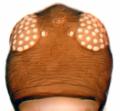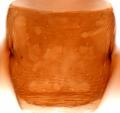Aeolothrips albicinctus
Recognition data
Distinguishing features
Both sexes usually with wings shorter than thorax width. Body color brown with abdominal segments II–III sharply yellow, mesothorax and abdominal segment X sometimes yellowish, antennal segments II and most of III yellow; legs brown. Head and pronotum with no long setae. Fore tarsus apically with stout recurved ventral hamus. Antennae 9-segmented, segments III–IV with linear sensorium short and straight, V–IX forming a single unit with V longer than VI–IX. Abdominal tergite I with many closely spaced transverse striae; sternal marginal setae arising sub-marginally, particularly the two lateral pairs.
Variation
Fully winged females are rare, and have the wings relatively short with transverse dark and light bands.
Related and similar species
Two further species known from California have the basal abdominal segments sharply yellow, A. auricestus and A. brunneipictus, and at least two other Aeolothrips species occur in western USA with the abdomen bicolored, A. aureus Moulton and A. bicolor Hinds. These five species apparently all live at ground level as predators of small arthropods. Just over 90 species are placed currently in the genus Aeolothrips, of which more than 50 are from the Palaearctic Region (mainly Europe), and 28 from the Nearctic (mainly western USA). Only two species are recorded from the Neotropics; the one from Chile is probably the same as A. fasciatus, and one from Panama is probably not a member of this genus (Mound & Marullo, 1996).
Taxonomic data
Current valid name
Aeolothrips albicinctus Haliday
Original name and synonyms
- Aeolothrips albicinctus Haliday, 1836: 451
- Aeolothrips flavithorax Priesner, 1926: 102
Family placement
Aeolothripidae
Biological data
Life history
Predatory, probably on mites; behavior distinctively active and wasp-like.
Host plants
Living at the base of grasses
Tospoviruses vectored
None
Crop damage
None
Distribution data
Area of origin
Western Europe
Distribution
Widespread across Europe into Asia, also North America (Ontario, New York, New Jersey, Massachusetts, Illinois, Iowa, California).






